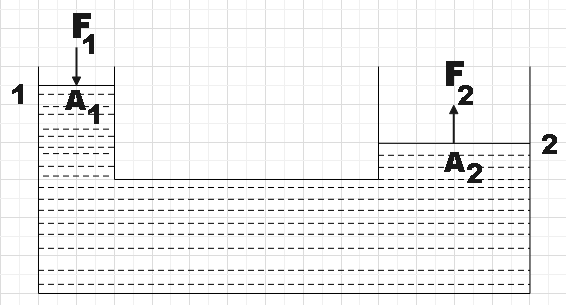
The diagram below shows a hydraulic lift. A force is applied at side 1 and an output force is generated at side 2. Which of the following is true?

A. The force at the side 1 is greater than the force at side 2.
B. The force at the side 1 is less than the force at side 2.
C. The pressure at side 1 is greater than the force at side 2.
D. The pressure at side 1 is less than the pressure at side 2.

Answer
525.6k+ views
Hint: You could think of the principle behind the working of a hydraulic lift. Then, you could think of the condition that has to be satisfied for following that particular principle. As per the dimensions of the given container you could find which among given conditions is correct.
Complete step by step solution:
In the question, we are given a hydraulic lift with two sides 1 and 2. We are given certain conditions on the force and pressure in the given options and we are supposed to find which of them is true. In order for us to answer this, we should know what Pascal’s law is.
Pascal’s law states that by causing a change in pressure to an enclosed fluid, this change in pressure is equally distributed to all portions of that liquid along with the walls of its container.
Hydraulic lift basically is an application of Pascal’s law. So, the change in pressure on both sides will be the same. That is,
$\Delta {{P}_{1}}=\Delta {{P}_{2}}$
$\Rightarrow \dfrac{{{F}_{1}}}{{{A}_{1}}}=\dfrac{{{F}_{2}}}{{{A}_{2}}}$
$\Rightarrow {{F}_{1}}{{A}_{2}}={{F}_{2}}{{A}_{1}}$ ………………………………. (1)
However,
${{A}_{1}}\langle {{A}_{2}}$ …………………………………… (2)
So quite obviously, ${{F}_{1}}$ should be less than ${{F}_{2}}$ in order to satisfy equations (1) and (2).
Hence, option B is the correct answer.
Note: We could explain Pascal’s law at atomic level. The atoms within an enclosed fluid are free to move about. Their movement causes the change in pressure caused at one point to be distributed undiminished throughout the container along with its walls. So, in a hydraulic lift we get a huge output force by applying a very small input force.
Complete step by step solution:
In the question, we are given a hydraulic lift with two sides 1 and 2. We are given certain conditions on the force and pressure in the given options and we are supposed to find which of them is true. In order for us to answer this, we should know what Pascal’s law is.
Pascal’s law states that by causing a change in pressure to an enclosed fluid, this change in pressure is equally distributed to all portions of that liquid along with the walls of its container.
Hydraulic lift basically is an application of Pascal’s law. So, the change in pressure on both sides will be the same. That is,
$\Delta {{P}_{1}}=\Delta {{P}_{2}}$
$\Rightarrow \dfrac{{{F}_{1}}}{{{A}_{1}}}=\dfrac{{{F}_{2}}}{{{A}_{2}}}$
$\Rightarrow {{F}_{1}}{{A}_{2}}={{F}_{2}}{{A}_{1}}$ ………………………………. (1)
However,
${{A}_{1}}\langle {{A}_{2}}$ …………………………………… (2)
So quite obviously, ${{F}_{1}}$ should be less than ${{F}_{2}}$ in order to satisfy equations (1) and (2).
Hence, option B is the correct answer.
Note: We could explain Pascal’s law at atomic level. The atoms within an enclosed fluid are free to move about. Their movement causes the change in pressure caused at one point to be distributed undiminished throughout the container along with its walls. So, in a hydraulic lift we get a huge output force by applying a very small input force.
Recently Updated Pages
Master Class 12 Business Studies: Engaging Questions & Answers for Success

Master Class 12 Economics: Engaging Questions & Answers for Success

Master Class 12 English: Engaging Questions & Answers for Success

Master Class 12 Maths: Engaging Questions & Answers for Success

Master Class 12 Social Science: Engaging Questions & Answers for Success

Master Class 12 Chemistry: Engaging Questions & Answers for Success

Trending doubts
What is meant by exothermic and endothermic reactions class 11 chemistry CBSE

Which animal has three hearts class 11 biology CBSE

10 examples of friction in our daily life

One Metric ton is equal to kg A 10000 B 1000 C 100 class 11 physics CBSE

1 Quintal is equal to a 110 kg b 10 kg c 100kg d 1000 class 11 physics CBSE

Difference Between Prokaryotic Cells and Eukaryotic Cells




